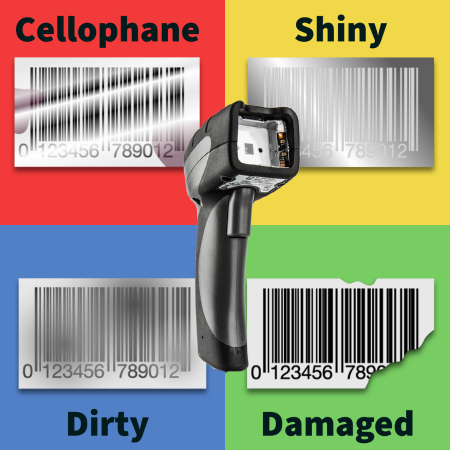A look at smartphone barcode scanning vs. barcode scanners
“Why do we need scanners if smartphones can scan barcodes?” It’s a common question given smartphones’ power and versatility. In fact, Tech Evaluate reported in early 2022 that the iPhone 13 boasts a superfast neural engine that performs up to 15.8 trillion operations per second. That’s way more than enough computing power to blast you to the moon!
So has the smartphone finally outsmarted barcode scanners (also called barcode readers)?
- To craft this blog about mobile barcode scanning (also called soft scanning), we consulted Vernon Witney at Code Corporation. Code has specialized in barcode scanning software and barcode scanners for 20+ years. Witney, Code Corp’s London-based solutions architect, and his colleagues have been asked many times to explain the differences between barcode scanning with a dedicated device or a smartphone.
To understand the differences between barcode scanning with a smartphone versus a purpose-built barcode scanner, we asked:
- Can a smartphone read any barcode?
- Why do you need a barcode scanner when you can scan with your phone?
Q: Can a smartphone read any barcode?
“In theory, any device with a camera can read a barcode—either 1D or 2D types,” Witney says.

Any camera-equipped smartphone can scan basic barcodes. Devices with barcode-scanning SDKs like Code’s CortexDecoder scan much more.
He explains that scanning technology has moved from Laser 1D scanning to CCD (Charged Coupled Device) 1D Scanning and now to image-based scanning.
“The big issue: Even though you can capture the image (i.e., barcode), you need to better process that image,” he shares. “And to process that image, a device must actually analyze the image, quickly find the barcode, and then actually decode it.”
Of course, barcode scanning speed matters.
“This is where we really differentiate between some applications and others,” Witney adds. “And it’s the better applications that can process the image quickly.”
While any camera-equipped smartphone can read a barcode, not all can read them well because it’s highly dependent on how a device processes the image and finds the barcode.
Other factors that may degrade smartphone barcode scanning performance are the actual barcodes themselves. A straightforward scan of a pub’s QR code for a menu or a QR code affixed to a rental car’s window is one thing. But what about barcodes or QR codes printed on metal, glass, or the glossy polyethylene terephthalate (PET) bags commonly used for consumer packaged goods. Smartphones’ native scanning apps (or free/freemium ones from app stores) employ basic decoding algorithms that can’t handle these reliably…if at all.

Dedicated barcode scanners are best for challenging conditions and imperfect barcodes.
In theory, any camera-equipped device can scan barcodes, but your experiences may vary.
Q: Why do you need a barcode scanner when you can scan with your phone?
“A barcode scanner performs one specific function, doing it very well and doing it very fast,” Witney shares. “And there are some applications where you need that speed and form factor.”
These barcode scanning use cases include original equipment manufacturers (OEMs) integrating a very small scanner into a device that scans barcodes to provide a product or service. A prime example is an Artech Kiosk that uses purpose-built barcode scanning hardware. Travelers and patients simply walk up to a kiosk, scan the QR code on their ticket or medical documentation and receive directions or test results.
A logistics firm might need to rapidly read barcodes on a high throughput system, like parcel sortation. Someone working at an automotive supplier’s warehouse might need to read barcodes from far away. Another user, such as a nurse, might need to read direct part mark (DPM) barcodes that are “embossed” on surgical tools and are very difficult to scan.
“All these applications suit a specific barcode scanner very, very well,” Witney adds.
Jack of all Trades, and a Master of Some…
“With the scanner built into a camera, for example, a user gets a very generic barcode scanner because there are lots of other functions that you can incorporate within the smartphone,” Witney illustrates.
For example: You might be using a smartphone as your barcode scanner, but it’s a very generic device. But if you want to incorporate that, for example, into a medical device for barcode scanning, it could be very expensive. So there are instances where you’d read barcodes using a very specific barcode scanner. And there are applications where a very generic scanner, for example, incorporated into a phone would work just as well.
A Conclusion & Caveat
It’s clear that soft scanning via smartphone is fine for day-to-day uses like scanning the QR code on a cosmetic kit to view tutorials or scanning a daily menu from your favorite takeaway stand. And there is one big caveat to address: Even within the hospitality, retail, manufacturing, and medical industries, smartphone-based scanning can be very effective if a smartphone is running a specializedbarcode scanning software development kit(SDK). SDKs, such as Code’s CortexDecoder, harness a smartphone’s camera to deliver enterprise-grade scanning through software instructions. However, purpose-built barcode scanners are likely the right call when:
- The barcode is complex.
- Battery life could cause downtime—a phone may not last a full shift.
- An application-specific device makes sense (you don’t need a screen, for example).
- You want to interface with a host system that only accepts hardware inputs, e.g., keyboard or RS232.
- Time, accuracy, and speed are mission-critical—throughput relies on you picking up a device, scanning once, and being done.
- Security and IP are concerns: If scanning a barcode in sensitive areas, it’s advisable to avoid an internet-connectable device that can capture high-quality images, which could then be leaked (inadvertently or maliciously).
- The environment is harsh and/or high-volume, e.g., many industrial applications.
- Scanners are disinfected routinely—it’s easier to do this with a product designed from the outset to be cleaned, such as a barcode scanner crafted with disinfectant-ready CodeShield® plastic.
Still unsure if smartphone-based scanning is right for your product, process, or project? Maybe you’re sure a barcode reader is the right decision, but unsure what’s the best barcode scanner?Contact Code, our data capture experts throughoutNorth America and EMEA have heard it and scanned it all; they’ll be happy to assist you.
Want to dig deeper intoTech Evaluate’searly 2022 article “Are Smartphones Considered Powerful Computers?” Visit it here.
Share This Post
Author

Paul Garcia
Many of the talented and qualified staff at Code Corporation contribute to our blog. Our team members add a unique perspective to our communications efforts, and we are fortunate to have such a great cadre of writers as part of our company.
